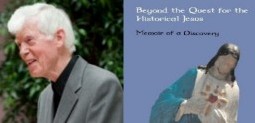 Chapter 14
Chapter 14
THE SHIPPING FORECAST: DEEPS BELOW AND A STORM AHEAD
.
Chapter 14 of Thomas Brodie’s Memoir of a Discovery is probably one of the volume’s most significant and it is to be regretted that some of Brodie’s critics have so totally avoided its message. This chapter strikes at the heart of what most of us at first find most challenging about Brodie’s thesis.
But first, let’s start where Thomas Brodie himself starts in this chapter. Let’s begin when he meets the new professor of New Testament at Yale Divinity School, Richard B. Hays, in the 1980s. There is a new wind beginning to blow in New Testament studies and Hays’ work is among those ships that have felt its first gusts. (We will see that many are still in denial and refusing to prepare.) Meanwhile, Hays invited Brodie to speak on Luke’s use of the Old Testament to his New Haven class.
 Richard Hays’ thesis has been published as The Faith of Jesus Christ: The Narrative Substructure of Galatians 3:1-4:11. Hays argues that a section of Galatians is a product of an author reworking a larger narrative about Jesus Christ and some of the Old Testament. Richard Hays’ thesis has been published as The Faith of Jesus Christ: The Narrative Substructure of Galatians 3:1-4:11. Hays argues that a section of Galatians is a product of an author reworking a larger narrative about Jesus Christ and some of the Old Testament.
Since then, Brodie informs us, Hays has become “a pioneer in narrative theology — in showing how New Testament narrative often builds a story or narrative that is grounded on that of the Old Testament”. Others have come along to complement his work. Some of these:
In acknowledging the importance of the Old Testament “allusions” or “echoes” in the New Testament, these works (according to Brodie) are “a real advance for New Testament research.”
|
But there’s a but . . .
Brodie’s optimism is tempered, however. The above “pioneers” speak of “echoes” and “allusions” and for that reason do not really do full justice to the way the New Testament authors re-worked/re-wrote the literature of the Old.
If many scholars have jumped at doing “history” with the Gospels before they have taken care to explore the nature of their literary sources, Richard Hays has been too quick to jump into doing theology. By that Brodie means that Hays has failed to appreciate that questions of theology can be significantly influenced by understanding how the texts being studied came to be put together, how they were transmitted. By understanding how authors put the texts together one can better appreciate the questions of theology they posed in their final products.
Hays can appreciate that the continuity between the narratives of Luke-Acts and of the Old Testament functions to give readers the theological message that they can have assurance in the continuity and reliability of God’s plan. But what he misses, according to Brodie, is that one of the most central factors of God’s plan was the composing of Scripture itself. So by studying the way Scriptures were composed, how they were sourced and put together, we can understand how God worked, how he implemented his plan. For Brodie, such questions are fundamental to truly appreciating the theology of the New Testament writings.
And the ineffectuality of “intertextuality”
The word intertextuality has been frequently used by scholars studying the ways New Testament authors made use of their literary sources but its meaning is also too often imprecise. The word originated with Julia Kristeva in 1966 and today is more commonly associated with anthropological questions of interaction between cultures, Several biblical scholars use the word to refer to concepts as light as “textual allusions” or “echoes”. This is fine insofar as it draws attention to the relationship between written texts. But Brodie is arguing that ancient writing involved much more than “allusions” and “echoes”:
The kernel of ancient writing was not in allusions: it was in taking hold of entire books and transforming them systematically. VIrgil did not just allude to Homer; he swallowed him whole. And there are comparable systematic transformations within the Bible. Allusions and quotations were often little more than decorations and embellishments. (p. 127)
So what is the nature of the textual relationship that is at the core of Brodie’s argument if it’s more than “echoes” and “allusions”?
.
Transforming Texts Beyond Immediate Recognition
Spotting the differences between the following stories earns no points. But spotting the similarities AND being able to coherently explain them might yield rewards. Many scholars have discussed the comparisons of Luke’s narrative with its matches in Matthew 8:5-13 and John 4:43-54. Many commentators of the Lukan narrative have even been aware of the Naaman episode. Continue reading “Making of a Mythicist, Act 4, Scene 3 (Deeps Below, Storms Ahead)”
